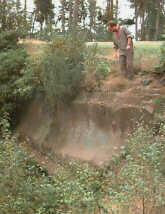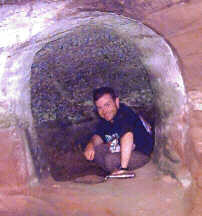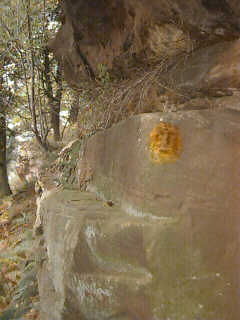In the eighteenth century, William Leche inherited the Hall from his father, John Leche. He started work on the construction of a Romantic landscape around the cliff some time between 1765 and 1776. We initially assumed that the features we could see were all part of the Park created in the early years of the nineteenth century but have since discovered that a Leche family document of 1776 refers to a pleasure garden of only four acres, which must be the cliff-side landscape.

 Although
the cave with the Mesolithic and eighteenth-century occupation
was largely left alone as it formed the dramatic end point of the
walk, other parts were modified drastically. In one place a whole
section of the hillside seems to have been cut away and
remodelled to produce a broad platform, with the cliff at the
back (east). In the newly-exposed rock face were a number of
overhangs. At least one of them was paved with massive sandstone
slabs; next to it a small circular niche was carved. This seems
to have been used at some point for burning coal, although we
cannot begin to guess at its purpose.
Although
the cave with the Mesolithic and eighteenth-century occupation
was largely left alone as it formed the dramatic end point of the
walk, other parts were modified drastically. In one place a whole
section of the hillside seems to have been cut away and
remodelled to produce a broad platform, with the cliff at the
back (east). In the newly-exposed rock face were a number of
overhangs. At least one of them was paved with massive sandstone
slabs; next to it a small circular niche was carved. This seems
to have been used at some point for burning coal, although we
cannot begin to guess at its purpose.
 In other places, existing niches were remodelled to provide
seats. In most instances, they were designed to give the best
views over Carden Hall, but in one or two cases, they were
focused on Stretton Hall, a couple of kilometres away, which was
owned at that time by William’s younger brother, John.
William’s manipulation of the landscape was cleverly
thought out and designed to heighten an appreciation of just how
much land he owned. At the end of the walk, his visitors were
presented with the dramatic cave where we have been excavating
and a panorama stretching from Chester to the north to Tilston to
the south. In one view, we have all of William Leche’s
life: business interests at Chester, religious interests in
Tilston (where the parish church is to be found) and everything
in the foreground belonged to him, including the house, the
estate and his farms.
In other places, existing niches were remodelled to provide
seats. In most instances, they were designed to give the best
views over Carden Hall, but in one or two cases, they were
focused on Stretton Hall, a couple of kilometres away, which was
owned at that time by William’s younger brother, John.
William’s manipulation of the landscape was cleverly
thought out and designed to heighten an appreciation of just how
much land he owned. At the end of the walk, his visitors were
presented with the dramatic cave where we have been excavating
and a panorama stretching from Chester to the north to Tilston to
the south. In one view, we have all of William Leche’s
life: business interests at Chester, religious interests in
Tilston (where the parish church is to be found) and everything
in the foreground belonged to him, including the house, the
estate and his farms.